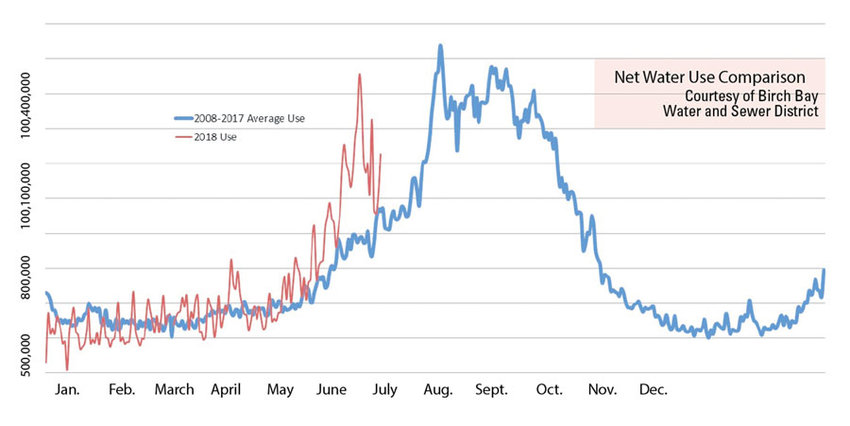
By Oliver Lazenby
Blaine and Birch Bay residents used record amounts of water last month, and the trend may continue if the sun keeps shining.
Birch Bay Water and Sewer District (BBWSD) customer usage peaked around 1.35 million gallons on one day late in the month, a district record for May and a more-than 50 percent increase from the average daily use in past Mays, said Dan Eisses, BBWSD general manager. The city of Blaine saw similar numbers, public works director Ravyn
Whitewolf said.
BBWSD attributes high water use mostly to weather. Birch Bay received less than a third of an inch of rain for the month. From 2010 through 2017, Birch Bay averaged 2.35 inches of rain in May. High temperatures this year averaged 70.6 degrees, more than 3 degrees warmer than the average high temperature in May for the past six years, according to data compiled by Mike Sowers, BBWSD operations manager.
There may be other explanations for high water use in May, such as snowbirds returning home earlier than usual because of the weather and increased development in the area but Eisses thinks weather accounts for most of the spike.
“This could be people thinking, ‘I don’t want my lawn to turn brown now. I’m OK with it turning brown in July, but this is too early,’” he said. Eisses watered his lawn in May, something he never does, to prepare for a graduation party in June, he said.
Eisses and Whitewolf expect higher than average water use to continue if the weather remains warmer and drier than average. So far, June is off to a hot start.
“For May and now going into June, we have the warmest temperatures that we’ve seen in the last 7-8 years,” Sowers said in an email. “Combined with the lack of precipitation, it’s easy to see why our water usage has been up, and why conservation (and public notification and education) efforts are as important as ever.”
Voluntary watering schedules are a key part of local conservation efforts.
In both Blaine and Birch Bay, residents with odd-numbered street addresses are asked to limit watering to Sunday, Wednesday and Friday. Those with even addresses should water on Tuesday, Thursday and Saturday. Mondays are non-watering days.
People can take additional conservation steps including letting lawns rely on rainwater, installing efficient toilets, taking shorter showers, and using dishwashers and washing machines with only full loads.
BBWSD implemented the voluntary watering schedule in 2008, and it has succeeded, along with other conservation measures. Average daily water use dropped by about 150,000 gallons a day between 2009 and 2011. Simultaneously, the district hired a conservation specialist and began working more on education efforts.
Average daily water use has crept back up since 2011, but it is still lower than it was in 2009.
The recession may also have affected water usage during that period. Eisses suspects some changes people made during the recession have lasted even as the economy has improved.
“Once they let the lawn go brown one year and they realize, hey I don’t have to mow it and I don’t have to water it and it comes right back in the fall … I think that’s a lifetime change,” he said.
The “peak day,” or the one day a year when customers use the most water, tends to be on or near July 4. Peak water use topped out at just more than 1.5 million gallons a day on July 4 weekend the past two years. More people coming to Birch Bay for 4th of July could affect peak days, as Bellingham banned fireworks in city limits in 2013.
Water districts focus their conservation efforts on bringing down peak use rather than daily use, because they have to build infrastructure to handle the peak day, Eisses said. Infrastructure costs aren’t lowered if the average use decreases without peak use also decreasing.
“The theory is, the more we can tamp down that max day use, when we replace the pumps and pipes and drill new wells and look for new water, we don’t have to look for as much.” Eisses said. “There’s some significant cost savings involved in keeping that max day down.”
Comments
No comments on this item Please log in to comment by clicking here